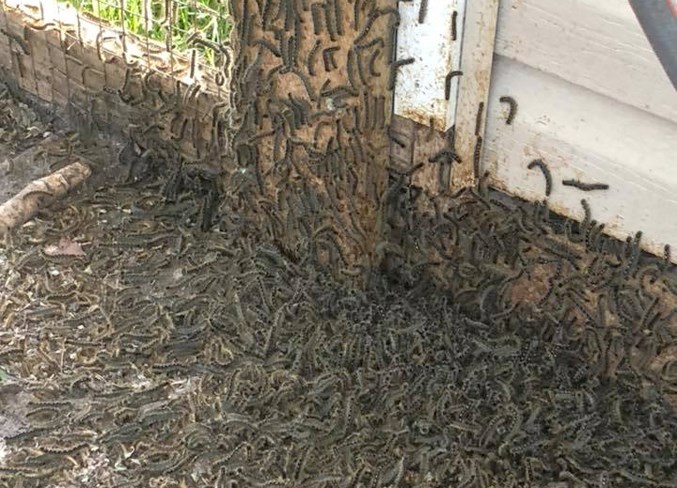Over the last couple weeks, many area residents have been able to get up close and personal with a certain insect - whether they like it or not. What many people may not realize is that forest tent caterpillars are an important part of the boreal forest.
Caterpillars have been noted throughout the Lakeland area this spring, with residents posting images and videos to social media showing thousands of the insects climbing on houses, being squished along the highway, and defoliating trees along the way.
Caroline Whitehouse is a Forest Health Specialist with Alberta Agriculture and Forestry in the Forest Health section. She explains that forest tent caterpillars are abundant in the boreal forest.
She confirms that the caterpillars go through cycles, which typically last two to three years, but can be up to five years. Usually, there is a 10 to 15 year space in between cycles.
In 2006, an outbreak in the High Level area affected about five million hectares of trees. In 2013, an outbreak in the Peace River/Slave Lake/Lac La Biche area affected about four million hectares, says Whitehouse.
In 2017, the area around St. Paul was affected by forest tent caterpillars, confirms Whitehouse. She described it as a smaller localized outbreak, affecting only about 594,000 hectares. This year's affect has yet to be measured.
In late June and into July, the department will do aerial overview surveys, and map any large-scale disturbance.
"We'll have a better idea of this year's deforestation after we do that," she explains.
When it comes to the affect the insects have on trees, Whitehouse says that typically, trees can re-flesh their leaves and recover. But if defoliation occurs in the same spot for multiple years, trees can suffer. And if those areas overlap with areas experiencing drought, then it seems to be a two-fold hit on trees, which can make it hard to recover.
Sometimes during an outbreak, there is an intense competition for food, and the forest tent caterpillars will move on from its usual preferred meal - the trembling aspen - to other types of trees.
"They'll just be desperate for food of any kind," says Whitehouse. But, when they feed on other trees, they don't get the same nutrients, which eventually contributes to a decline in population.
The province does not control forest tent caterpillars, since they are a "natural defoliator," explains Whitehouse. The insects are an important organism in the boreal forest.
Simply put - "they're pooping a lot," says Whitehouse, and that helps speed up the nutrient cycling, making more nutrients available for other life. The defoliation also opens up the forest canopy, allowing more light to infiltrate the forest floor.
The increased number of caterpillars in an outbreak also provides food for natural predators - such as the grey house fly. Those flies lay offspring on the caterpillar cocoons, which then eat the developing forest tent caterpillar.
Dr. Maya Evenden a professor at the University of Alberta, Department of Biological Sciences, also offered insight on the insects. She noted that outbreak duration and periodicity varies by location.
"Severe defoliation can last two to three years," she confirmed. She also reiterated that most of the "control" of the insect is achieved by natural enemies, including parasitoids, disease and predators. And those enemies are already present in the ecosystem.
She also pointed to the province's aerial surveying as a way to measure defoliation. She noted that "they used to do province-wide monitoring with pheromone-baited traps, but that was discontinued some time ago."
Once the province completes this year's aerial surveys, information will be made available to the public online. People with questions about forest tent caterpillars can also contact their local forest health office. The nearest officer to St. Paul is Fraser McKee, located in Lac La Biche.



